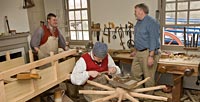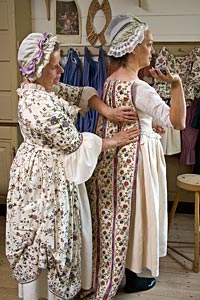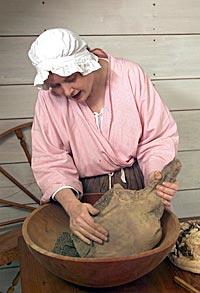Page content
Online Extras
Trades Slideshow


Author Jay Gaynor with wheelwrights Paul Zelesnikar, left, and Andrew DeLisle, working on a spoke, at the Elkanah Deane Shop

Wheelwright Paul Zelesnikar, left, and founder Mike Noftsger use a block and tackle to lift a coehorn mortar from its mold.

At the blacksmith’s shop, practiced tradesmen fashion nails in the eighteenth-century manner for use in Historic Area structures.
Why Do We Cast Cannons, Make Wooden Wheels, and Build Coffeehouses?
by Jay Gaynor
Back in the 1970s, I was involved in launching Ohio Village, a living history museum near Columbus. It portrayed an antebellum town, a village with a square around which stood shops where craftspeople followed nineteenth-century trades. Shortly after opening day, I was having Sunday dinner with friends and their elderly—to me at the time, anyway—parents who had visited the museum. I asked the husband, Mr. Bradley, what he thought of it. He gave me the usual, polite “enjoyed it, nice place” answers. So I said something like, “Come on, Mr. Bradley, tell me what you really think.” His reply was not what I expected. He said something like: “Well, it was good, but everyone was thinking too much.”
Explain, please.
“When I was a kid in New England, we used to wander by the tinsmith or blacksmith after school, and they didn’t think about what they did. They just did it. You folks spend a lot of time drawing and calculating and measuring and figuring out. You think too much.”
Maybe it’s ironic, but I’ve thought a lot about Mr. Bradley’s observation about not thinking.
In one way, he was right. An eighteenth- or nineteenth-century apprentice served a master or mistress much more concerned about productivity than creativity. By the time the kid had grown up, the young artisan knew what worked, and knew how to make it work as expeditiously as possible. He had to if he wanted to compete and make a living.
In another way, as I’ve worked with Colonial Williamsburg’s Historic Trades, I’ve come to realize that it isn’t that simple. Those old craftsmen were constantly thinking—probably subconsciously—and making hundreds of practiced decisions with every move, every examination. It isn’t whether we think more or less as we go about traditional work; it’s the kind of thinking that’s the difference.
Historic Trades works to learn ever more about eighteenth-century objects, how they were made, and the world in which they were made. We do it by examining and interpreting the written and visual documents left to us by producers and consumers; studying original objects for the clues embedded in them; and experimenting, hands-on, to redevelop the knowledge, skills, materials, and tools to replicate those objects. We preserve what we know by teaching new generations to practice these trades. We present what we know and what we do to Colonial Williamsburg’s audiences. None of this can be done unless we put our hands, heads, and hearts to work and make things.
Some of the products Historic Trades make are part of large projects like the outbuildings at the Peyton Randolph House or the Charlton Coffeehouse reconstruction. Other products are made at curators’ requests to be used in our museum or other museums around the country. Some are made to be sold at Colonial Williamsburg stores. Individuals custom-order others. We make some, like the new Revolutionary War–period cannon, chocolate for our cooking programs, and the fire engine in the 1980s, because, well, why not? They are interesting and intriguing things. We can use them in our interpretive programs. Their production presents challenges and learning opportunities. It sounds like fun.
But, first and foremost, what we make aids our preservation and presentation of centuries-old technology. The products themselves are, in a way, a by-product. That they are faithful reproductions or plausible reconstructions is important—they look, feel, sound, smell, taste like eighteenth-century things. It’s more important that they are that way because we went about making them as they would have been made two-hundred-odd years ago.
Discovering how eighteenth-century artisans made things forces us to think. Some of what we consider is obvious and concrete. Is this the correct material? Are we using the right tools? Is this too thick, too thin? Does it fit closely enough? Does this finish look right?
But we also wonder why they made things in a particular way. Often, period products don’t make sense to our twenty-first-century way of thinking. We are indelibly influenced not only by modern materials, technologies, markets, and marketing but by modern science and mathematics, the analysis and engineering of research and development, and a host of post-Enlightenment and postindustrial approaches and philosophies. Aspects of the products strike us as irrational. It is only when we try to get inside the heads of the original producers that we begin to understand that there was almost always a rational reason—or a rational nonreason such as that it wasn’t important to them—if evaluated within their systems of production, consumption, aesthetics, and philosophy. We soon learn that we cannot make accurate renditions of period products unless we are willing to think like period producers—or at least be cognizant and willing to play by the rules of their environment and their motivations.
We have to know that most producers were driven by an empirical knowledge of what worked, not a desire to know why or to improve for the sake of improving. We have to know the relative costs of materials. We must realize that the materials that went into many products were more expensive than the labor involved, and that eighteenth-century goods often reflect the desire to minimize the cost of materials at the expense of making their production more laborious.
We have to know what decisions artisans and their customers made about what was important. Was it important that every aspect was as well fashioned and finished as possible? Or was it, in an age when fashioning and finishing were done in stages and could be stopped at innumerable points along the way, more reasonable to be selective? Make sure what is seen is just right. As long as it is sound mechanically, who cares about the finish on the back or bottom? How precise do flat, smooth, round have to be? Most artisans were paid by the piece rather than by the hour or day, and the more one made, the more likely one was to eat—and drink—well. What were the production results? The list goes on.
We begin to realize and understand these influences by reading the documents and studying the artifacts, but the surest and most revealing process is attempting to re-create the production methods and products until we get them right.
So we make everything from andirons to wigs out of curiosity and for the challenge to discover, re-create, and see how well what we do stacks up with how well they did. The excitement of exploration and the joy of creating. But also to be gained may be useful knowledge. What were the alternatives to modern thought and manufacture? We know they worked—their results survive for us to see and touch, and often admire. What might we learn from them? What might we adapt from them? Are they greener? More flexible and responsive? More sustainable? More satisfying? Do they promote attitudes toward our material world that will enrich our lives today?
I believe they do—if we share what we are doing.
Our work tells us a lot about artifacts of the past. Objects—the physical remains of the past—are the only real and incontrovertible things of history. The thoughts and prephotographic visual portrayals of the past, conveyed to us through written documents, drawings, prints, and paintings have always recorded facts selectively. They have been written and composed with biases, some intentional, others not. The book and paper and ink and penmanship are real. They are more straightforwardly truthful than the words and thoughts they convey. We can gain insights about attitudes, priorities, needs, status, economics, and other aspects of a period through the study of objects that are not recorded or demonstrated any other way.
I think what we do can help people look anew at objects. We are buried in our material possessions, but how many of us really see them? The process of re-creation forces us to really look at and experience objects. We have to engage them with a personal intimacy. There is no better way to understand something than to make it with your own hands.
The things we make are eighteenth century, but the processes of looking, noting details, comparing, analyzing, being forced to make decisions—objective or subjective—about what is successful in design, fabrication, and decoration, and why, are exercises that could only improve our world. Trades artisans have to explore aesthetic and mechanical design influences and systems, consumer preferences, and material culture to do our jobs. Moreover, we enjoy it, and we can encourage and empower others to do it.
We can transmit the capability to make things and the joy that comes with it. In our virtual age, fewer persons are engaged in hands-on creation. Sewing repairs, cooking, model building, and car maintenance are done less frequently than in the twentieth century. If a guest watches what we do, he or she may be amazed at the skill or speed, but the processes are comprehensible—and doable. I was in the blacksmith shop a couple of years ago, standing in the back while a group of folks watched a smith hammering at the anvil. The guests listened to another talk about the work. They held the forged products in their hands, hefting them and running their fingers over them, seeing them. As I stood there, a mom, dad, daughter, and son walked past me to leave. The boy, he was nine or ten, took his dad’s hand, looked up to him and said, “This makes me really want to use tools.” I thought, yes, we’ve done a good day’s work today.
Our work also forces us to analyze and share the process of creation. We can be confused about that today. In the segmented, specialized, cubical-ized world of contemporary design, separated from the world of manufacture—itself often complex in organization as well as process—we can lose sight of the differences between design and novelty, quality and elaboration, creation and inertia, tools and process. Sometimes we find it difficult to determine what controls what. To do what Historic Trades does, we have to know the difference between tools, the essentially neutral implements we employ; technique, the tactical way in which tools are applied to the task; skill, the finesse and knowledge with which the application is performed; and technology, the bigger-picture system that links the elements for productive harmony. It is not a very complicated paradigm, but it’s one we can lose sight of and miss alternatives to the ways we do things.
We make cannons, fire engines, and gowns; build wagons, swivel-breech rifles, and coffeehouses; and dive into complex teapots and desks-and-bookcases for ourselves.
These new and bigger projects force us to push the envelope. We go places we haven’t gone before. We look more. We are forced to experiment. We develop new skills and techniques. We may fail at first, but we do better the next time. We learn more.
Many projects are group undertakings, and we have the satisfaction of blending our knowledge and skills. It’s like making music. Solo performances can impress us with their creativity and virtuosity. But symphonies, with each musician, each section doing its independent but incomplete part, have richness and diversity that only group efforts can create. Colonial Williamsburg’s Historic Trades program is one of few, perhaps the only, that can begin to re-create the cooperation and complexity of an eighteenth-century production system. There is a satisfaction in teamwork, especially when our enthusiasm spills over and it draws others from the outside to lend us their expertise and skills, too.
Because we are historians, experimenters, risk takers, professional communicators, we like to tell intriguing and entertaining stories. Everything we make is a story. It has a beginning, a climax, a denouement, an end. Whether it’s a nail that takes thirty seconds or a building that takes years, the process and the product give us stories to tell and, ultimately, speak for themselves. Anyway, something to think about. . . .
Author Jay Gaynor, Colonial Williamsburg's director of Historic Trades since 2001, says, “I can take little credit for the ideas I've tried to express. They are the distillation of countless conversations with tradespeople, curators, and collectors; reading insightful correspondence, articles, and books; and a couple decades of sitting back and watching what's going on—and wondering why it is so fascinating.” He contributed to the winter 2004–5 journal, “A History of Historic Trades.”


